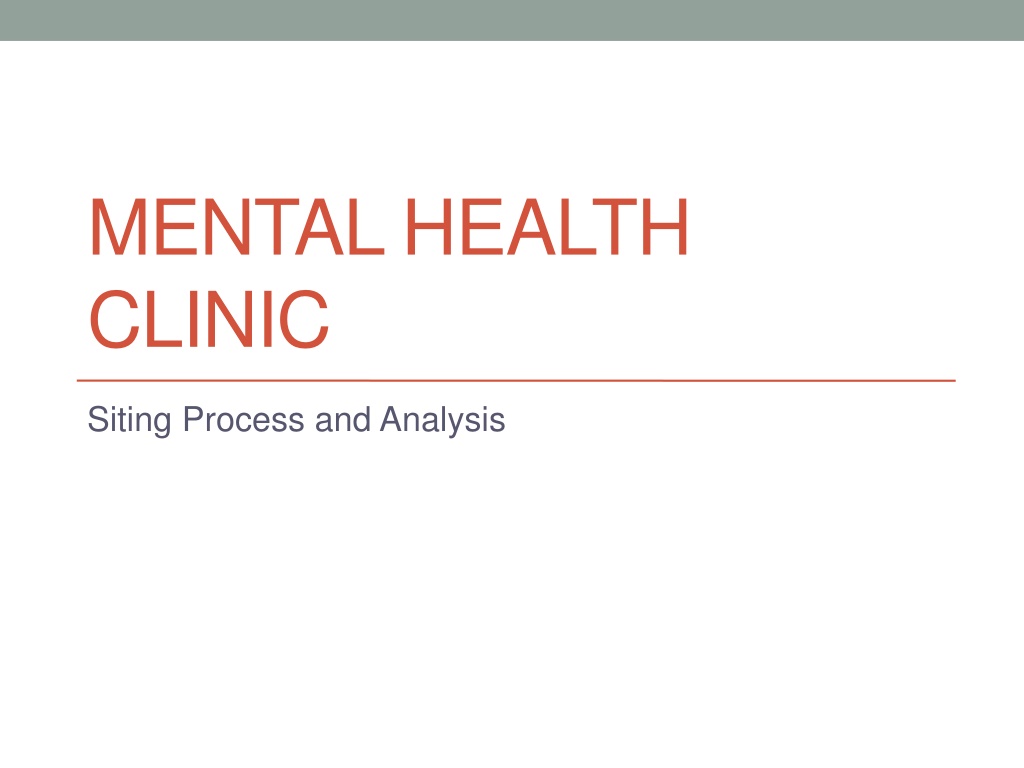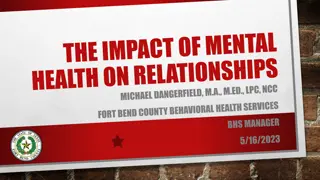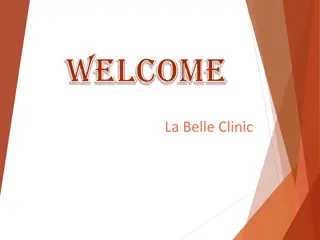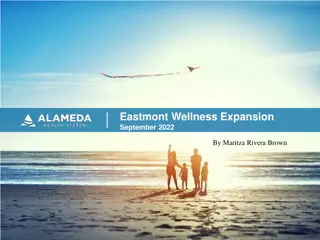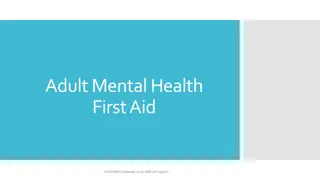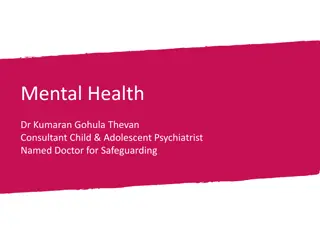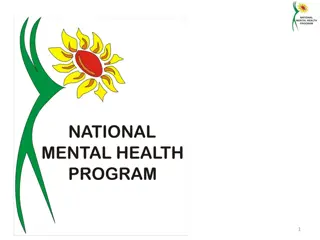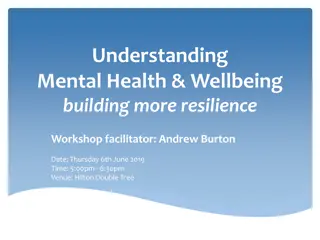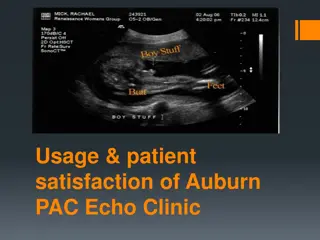Mental Health Clinic Siting Process and Analysis
The mental health clinic in Walton has faced space constraints since the 1970s, leading to the need for a new location to consolidate services. The Community Services Board has been overseeing this process, exploring rental space options and considering proposals for relocation. Committees and sub-committees have been appointed to coordinate the siting study and involve relevant county departments. The aim is to find a long-term solution to meet the needs of the Mental Health Department effectively.
Download Presentation

Please find below an Image/Link to download the presentation.
The content on the website is provided AS IS for your information and personal use only. It may not be sold, licensed, or shared on other websites without obtaining consent from the author.If you encounter any issues during the download, it is possible that the publisher has removed the file from their server.
You are allowed to download the files provided on this website for personal or commercial use, subject to the condition that they are used lawfully. All files are the property of their respective owners.
The content on the website is provided AS IS for your information and personal use only. It may not be sold, licensed, or shared on other websites without obtaining consent from the author.
E N D
Presentation Transcript
MENTAL HEALTH CLINIC Siting Process and Analysis
Background The mental health department outpatient clinic has been located in Walton since early 1970 s. The space was outgrown by 1985, when the substance abuse outpatient clinic moved to Hamden. In early 1990 s children and families mental health unit moved to rental space in Walton. The Community Services Board (CSB) has statutory responsibility to oversee the mental health department operations and documents from early 2000 s recognized the need for additional mental hygiene program space.
History - Continued The annual Local Services Plan for mental hygiene services has identified the need for adequate and appropriate space for behavioral health service delivery since 2011. State regulatory agencies (Office of Mental Health and Office of Alcoholism and Substance Abuse) support integrated care which can only be accomplished in a single location. Through 2012-2013 the CSB explored rental space options to consolidate all three outpatient clinics into one location. This proved daunting as needs required at least 10,000 sq. feet with adequate parking (100 cars) and a central county location. Locations identified required extensive renovations or had limited access.
History - Continued In March 2014 the CSB strongly recommended to the Community Health Committee of the Board of Supervisors to consider options to consolidate the mental health department. A Request for proposals was initiated and all options were considered. CSB looked for input from county regarding financial parameters. Community Health Committee met in July 2014 to discuss proposals. Consensus was to look for a long term solution for the needs of the Mental Health Department and expressed a commitment to work together to explore all options, including new construction. It was recommended that CSB reject all three proposals.
Charge to Staff August 2014 Chairman Eisel & Tina Mole requested Planning coordinate a siting study for the proposed relocation of the Mental Health Clinic partnering with the Department of Public Works and any other County Departments necessary. DPW and Planning outlined and agreed to the process in September 2014. Chairman Eisel appointed a special committee to oversee the process.
Mental Health Sub-Committee Established September 2014 Membership BOS Community Health Committee, Community Service Board Members Meetings held between September 2014 through January 2016 Technical Advisory Staff (TAS) Mental Health, Department of Public Works & County Code Enforcement and Planning Department
Funding $329,000 grant award 50% each State & Federal funding for the co-location of Mental Health and Drug & Alcohol Services into a single facility. 50% of the funding is reserved for needs assessment activities and the second half for technological specific upgrades to a new facility.
General Process 1. Review Information Gathered to Date 2. Consideration of Options Lease v. Own, PSB 3. Needs Assessment & Review of Programs 4. Siting Study 5. Site Selection - State Environmental Quality Review Compliance 6. Preliminary Design 7. Final Design 8. Bidding Phase 9. Construction 10. Construction Inspection
Consideration of Options Lease - Initial RFP for leased space requested 10,000 square feet all proposals. Committee members conducted a financial analysis of cost of long-term leasing. DPW provided costs estimates for construction of new structure. Committee decided to move ahead with owning a structure. Siting study to include buildings with structures as well as building a new facility. Committee asked for an evaluation of constructing the 2nd floor of the Public Safety Building.
Public Safety Building Research was conducted on the existing public safety facility, its construction/suitability of a second floor addition as well as information from the project coordinator on the process that was followed for that project. Input from the original contractor was sought to verify what additional floor area could be supported by the existing construction design. This information was also presented to the County Code Enforcement Officer for his input. Review also revealed additional parking areas that were not constructed to accommodate other site amenities. Due to cost the Public Safety Building was removed from consideration.
Needs Assessment & Program Evaluation Needs assessment: The Committee identified what departments are going to be located in the building. Programming phase: Committee and Planning interviewed Mental Health staff and other agencies that interact with the clinic to determine space needs. The special needs for the department Their relationship with other public and private agencies for operational needs Proximity to law enforcement, hospitals, public transportation etc. Projections on future expansion or changes to operational regulations that might impact the size or location of the facility, etc. Interviews and Committee discussion indicated a need for at least 15,000 with 20,000 square feet for possible future needs.
Siting Study Initial Criteria for Parcel Review Conducted by Planning Geographic Information Staff Availability of Public Water & Sewer Flood Hazard Areas Wetlands (National Wetlands Inventory) Slope Delineation Distances to Police and Emergency Services Added Utilities Electric, Oil, Natural Gas Internet Hospital Proximity Road Access State, County, Local
Site Visits Site visits were conducted on the top ten ranked sites. The site visits were conducted by the DPW Commissioner, the County Code Enforcement Officer and the Planning Department s GIS Coordinator. Site conditions were evaluated and the results were presented to the Committee. The sites were re-evaluated with the addition of the site visit information.
Current Status: Site Evaluations The Technical Advisory Staff proposed initial information gathering on the top three (3) preliminary sites selected. This would include information such as: Title search Phase 1A document review Property surveys Soil borings, etc. Committee authorized moving ahead with investigating the top three (3) sites. No site has been selected.
Next Step: Consultant Selection Prepare and circulate an RFQ for professional services which will include: Review of programming phase & site selection Assist with the evaluation of the top three (3) sites for suitability Final site selection and SEQRA compliance Conceptual Design Building footprint Stormwater management Access drives Sidewalks and general grading Identify HVAC and mechanical room requirements Identify security and IT requirements Size parking given codes Furniture, use existing or new Final Design and bidding documents Construction oversight
Next Steps: Establish a Capital Planning Committee for direct oversight and authorization of expenditures related to site evaluations. Present Community Service Board, Committee with additional information gathered on top three (3) sites. If a site(s) are suitable submit the sites to the consultant for review. Committee recommends site ranking and information to the Board of Supervisors. Board of Supervisors makes a final site selection.
